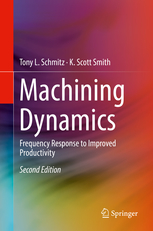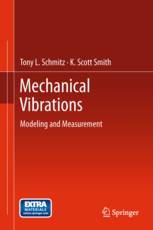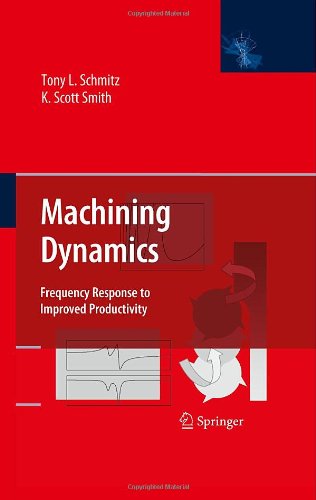Schmitz, T. and Smith, K.S., Mechanical Vibrations: Modeling and Measurement, Second Edition, Springer, New York, NY, 2020.
Mechanical Vibrations: Modeling and Measurement describes essential concepts in vibration analysis of mechanical systems. It incorporates the required mathematics, experimental techniques, fundamentals of modal analysis, finite element analysis, and beam theory into a unified framework that is written to be accessible to undergraduate students, researchers, and practicing engineers alike. Matlab programming solutions are integrated into the text through many numerical examples.

Schmitz, T. and Smith, K.S., Machining Dynamics: Frequency Response to Improved Productivity, Second Edition, Springer, New York, NY, 2019.
Machining dynamics: From frequency response to improved productivity trains engineers and students in the practical application of machining dynamics, with a particular focus on milling. The book is arranged such that the steps required to improve machining productivity through chatter avoidance and reduced surface location error (forced vibrations resulting in part geometric errors) are clearly evident. The following topics are covered in detail: modal analysis, including experimental methods, to obtain the tool point frequency response function; descriptions of turning and milling, including force modeling, time domain simulation, stability lobe diagram algorithms, and surface location error calculation for milling; and receptance coupling methods for tool point frequency response prediction, including beam theory. There are significant additions to the second edition, including a new chapter on machining tribology.

Davies, M. and Schmitz, T., System Dynamics for Mechanical Engineers, Springer, New York NY, 2014.
System Dynamics for Mechanical Engineers explains system dynamics using analogies familiar to the mechanical engineer while introducing new content in an intuitive fashion. The fundamentals provided in this book prepare the mechanical engineer to adapt to continuous technological advances with topics outside traditional mechanical engineering curricula by preparing them to apply basic principles and established approaches to new problems.

Schmitz, T. and Smith, K.S., Mechanical Vibrations: Modeling and Measurement, Springer, New York, NY, 2012.
Mechanical Vibrations: Modeling and Measurement describes essential concepts in vibration analysis of mechanical systems. It incorporates the required mathematics, experimental techniques, fundamentals of modal analysis, and beam theory into a unified framework that is written to be accessible to undergraduate students, researchers, and practicing engineers alike. To demonstrate and unify the various concepts, the Beam Experimental Platform (BEP) is used throughout the text. Engineering drawings for the BEP are included in an appendix so that instructors can provide their own demonstrations in the classroom. Additionally, Matlab programming solutions are integrated into the text through many numerical examples.

Schmitz, T. and Smith, K.S., Machining Dynamics: Frequency Response to Improved Productivity, Springer, New York, NY, 2009.
Machining dynamics: From frequency response to improved productivity trains engineers and students in the practical application of machining dynamics, with a particular focus on milling. The book is arranged such that the steps required to improve machining productivity through chatter avoidance and reduced surface location error (forced vibrations resulting in part geometric errors) are clearly evident. The following topics are covered in detail: modal analysis, including experimental methods, to obtain the tool point frequency response function; descriptions of turning and milling, including force modeling, time domain simulation, stability lobe diagram algorithms, and surface location error calculation for milling; and receptance coupling methods for tool point frequency response prediction, including beam theory.

 https://orcid.org/0000-0001-9955-5775
https://orcid.org/0000-0001-9955-5775